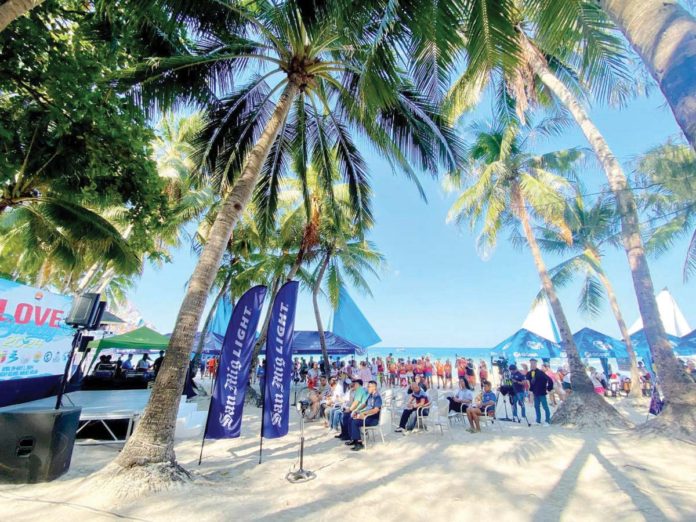
BY GEROME DALIPE
ILOILO City – The surge in tourist arrivals in Boracay may have brought positive economic benefits to this popular island, such as increased business opportunities for hotels, restaurants, and tour operators.
However, the huge tourist arrivals have breached the island’s limit to accommodate travelers, and this could have negative impacts including environmental degradation, strain on infrastructure, and even local communities.
But limiting the number of tourists entering Boracay remains a challenge, the Regional Development Council (RDC) admitted.
In 2018, then President Rodrigo Duterte ordered the island closed to tourists for six months for a comprehensive cleanup and rehabilitation. Beaches and waterways were cleaned, illegal structures were demolished, and waste management systems were improved.
The rehabilitation of Boracay was envisioned to ensure the island is a secure, globally competent, and world-class tourism destination with a vibrant, productive, and climate-resilient economy. Enforcement of environmental laws and government regulations was strengthened by implementing the 30-meter easement from the shoreline. Commercial establishments and households were also compelled to comply strictly with the provisions of the Clean Clear Act and the Solid Waste Management Act.
The rehabilitation also included efforts to regulate tourist activities, such as limiting the number of visitors and implementing stricter environmental regulations.
However, the RDC stressed that compliance with the carrying capacity limits for small island destinations with tourism potential remains challenging.
Citing a study commissioned by the Department of Environment and Natural Resources (DENR), the council said data showed Boracay can accommodate a maximum of 19, 215 tourists per day, or about 6, 405 arrivals per day based on an average three-day visit.
Despite such known information, the council said the tourist arrivals breached the limit. During Holy Week on April 14-15, 2022 visitor arrivals surged to 21,011, and 22,278, respectively.
To address such an issue, the council suggested the reinstatement of Boracay’s various protected areas on the Expanded National Integrated Protected Areas System (ENIPAS) areas list.
“Funding will be arranged to accommodate the necessary assessments and evaluation before its legislation,” read the council’s Regional Development Plan for 2023 – 2028.
This also includes close collaboration with the DENR with experts from non-government organizations, academes, local government units, and the RDC in conducting
To reduce vulnerability, it will enhance resiliency and disaster preparedness by ensuring the protection of environmentally critical areas, building disaster and climate resilience, and improving access to social service.
The council also noted that coordination between the local governments and the regional line agencies will be fostered to ensure projects have secured proper permits before funding and implementation.
It also vowed to continue formulating and updating comprehensive plans on safety and disaster mitigation and preparedness.
“These include disaster risk and reduction management plans, climate and disaster risk assessment, and climate change action plans, among others,” the council said.
It will also identify mitigating measures to minimize the impact of natural calamities to the vulnerable natural resources and assets including productive agricultural and fishery areas as well as physical and mental well-being and gender-based needs of those affected.
“The build-back-better principle will be continuously employed in the delivery of rehabilitation and recovery efforts to ensure inclusive and sustainable development,” the council added.
Likewise, the council noted population in the regional catalyzed population increased in municipalities such as Numancia and Malay in Aklan experienced a spillover of its population. Boracay is situated in Malay, Aklan. Hence, the tourism industry opportunities must make the area “desirable for living.”
“Efforts to effectively manage the region’s environment and natural resources pursued but upgrading and sustainability of legal status of existing protected areas still requires congressional action.
Likewise, the council also noted encroachment in hazard-prone areas in some parts of the region continues to complicate disaster risk and management efforts.
Such illegal activities contributed to flooding in lowland areas as evidenced during the onslaught of destructive weather disturbances like Typhoons Ulysses in 2020 and Odette in 2021 and tropical storms Agaton and Paeng in 2022.
“Aside from flooding, encroachment in hazard-prone areas exposed people and their properties to landslides and other hazards resulting in high cost of damage and losses to infrastructure housing and agriculture, as well in rehabilitation and recovery efforts,” the council stressed.
Bridge abutments and piers were sourced and rendered the bridges either destroyed, washed out, or unusable. Likewise, the council said that several cases of landslides were recorded in the region.
“Disaster relief and response were heavily affected considering the lack of redundancies in the existing road network to serve as alternative routes,” the council added./PN



